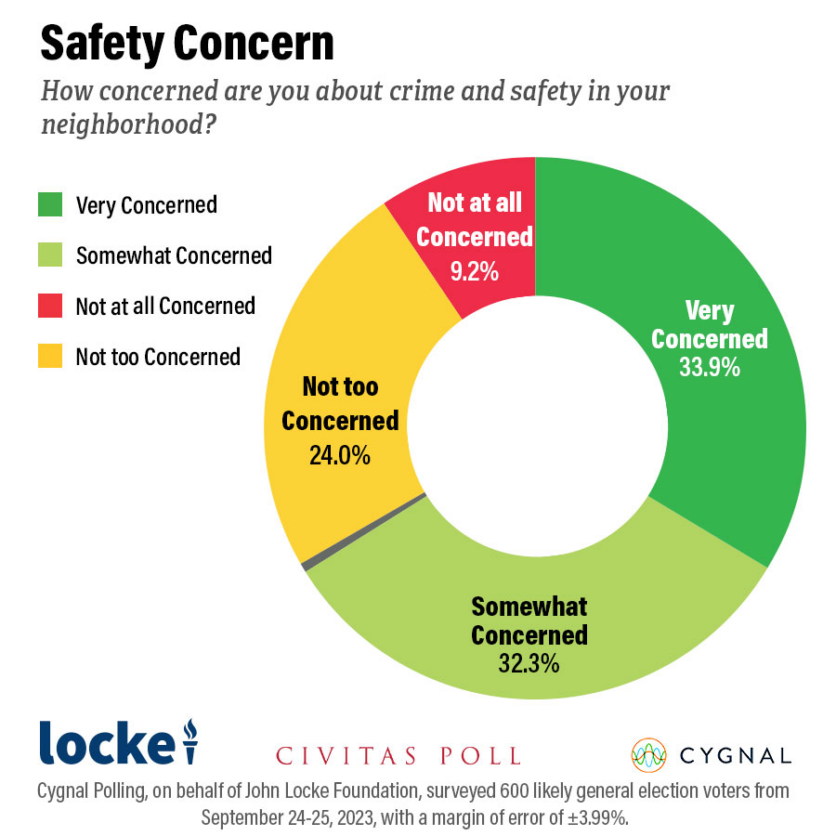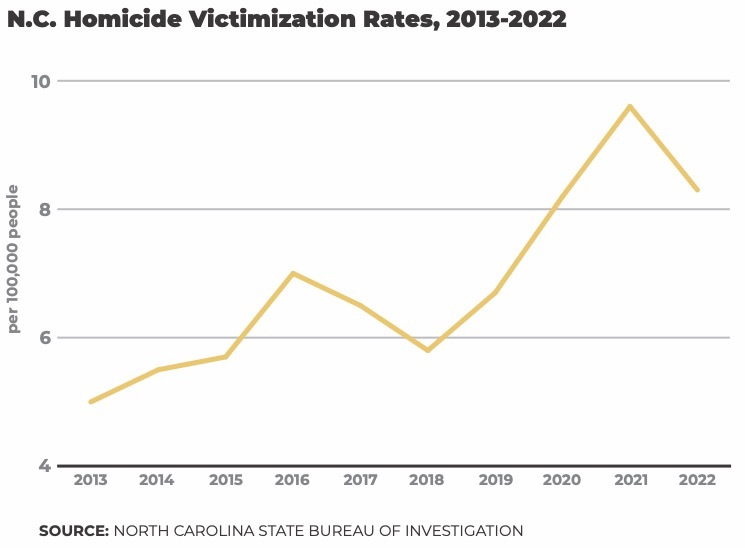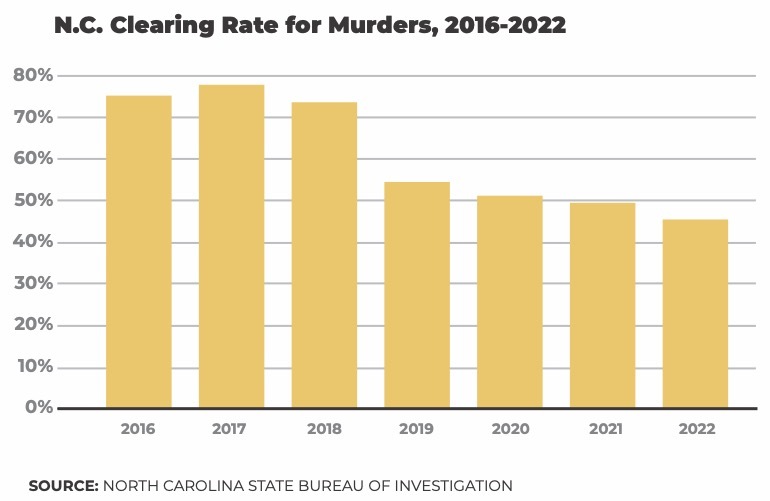- North Carolinians are worried about crime, and with good reason
- Crime levels spiked in 2020 and 2021 and remain significantly higher than in previous years
- On the other hand, the rates at which crimes are cleared by a charge being laid against the perpetrator have plummeted, which makes a return to pre-2020 levels unlikely in the short term
Note: This is the first in a series of research briefs about crime in North Carolina.
A recent Civitas poll found that almost two-thirds of North Carolinians are either very concerned or somewhat concerned about crime and safety in their communities.

They are right to be concerned. Crime rates in North Carolina have increased dramatically in recent years, with homicide leading the way. Between 2013 and 2019 the murder rate hovered at around 6.0 per 100,000. In 2020, however, it jumped to 8.2, and it jumped again in 2021 to 9.6, which is more than 50 percent higher than the pre-2020 average. Crime rates fell somewhat in 2022, but the murder rate in 2022 was still 24 percent higher than it was in 2019.

The rates for other kinds of crimes, including other kinds of violent crimes, also jumped in 2020 and 2021. The rate of aggravated assault, for example, increased by 15 percent over the course of those two years.
As noted above, crime rates abated somewhat in 2022, and we must hope and pray that that decline continues. Absent systemic changes in the operation of the criminal justice system, however, a sustained decline seems unlikely. Research has repeatedly shown that the best way to deter crime is to increase the likelihood of arrest and punishment. Unfortunately, arrest and punishment have become markedly less likely in recent years.
In 2017, when the murder rate was 6.5 per hundred thousand, almost 80 percent of all murders ended with a perpetrator being charged. That is known as the “clearance rate,” and, unfortunately, that rate has declined every year since then. In 2021, when the murder rate peaked at 9.6 per hundred thousand, fewer than 50 percent of all murder cases were cleared, and the clearance rate declined still further in 2022 to just 45 percent.

The clearance rates for other crimes declined just as precipitously over the period. For example, about 50 percent of all aggravated assaults were cleared in 2017. By 2022 the clearance rate for aggravated assault had declined to just over 25 percent.
What all this means is that more than half of all murderers and almost three-quarters of those who have committed aggravated assault are getting away with their crimes nowadays. Those who have committed less heinous crimes are even more likely to go unpunished. That is not the way to deter crime.
Despite the recent decline, crime rates in North Carolina are still higher than they were before 2020. They are also higher than the national average, and the disparity between us and the rest of the country has been growing. Our murder rate was about 20 percent higher than the national average in 2019, which wasn’t good, but it was more than 40 percent higher in 2021, which is very bad indeed.
It would be great if North Carolina could get its crime levels down to pre-2020 levels, and it would be even better if we could get them down below the national average. Even if we succeeded in doing those things, however, many North Carolinians will still have good reason to be concerned about crime. Crime rates vary from year to year and from state to state, but they vary much more from neighborhood to neighborhood. The residents of high-crime communities will always need to worry about crime.
Future installments in this series will discuss how crime particularly harms the residents of those communities and what can be done to improve matters, not just for those who live in such communities but for everyone who lives in North Carolina.
For more information about this topic, see:
- Intensive Community Policing Can Save the Lives of Black Children
- Black Lives Matter — Which Is Why We Need More Police Funding, Not Less
- The Late 20th Century Crime Wave Was a Disaster for Blacks and the Poor
- How America Ended Up Underpoliced and Overincarcerated
- Unless It Is Quickly Brought Under Control, the Current Crime Wave Will Be a Long-Term Disaster for Blacks and the Poor
- “Broken Windows Policing”: Good Policy, Bad Name
- More Cops, Less Crime
- What Does Intensive Community Policing Entail?
- Despite the Timing, Intensive Community Policing Should Have Wide Appeal
- Keeping the Peace: How Intensive Community Policing Can Save Black Lives and Help Break the Cycle of Poverty
- Prominent leftist suddenly sees that violence is bad, but for the wrong reason
- Why Defunding the Police Is a Terrible Idea


